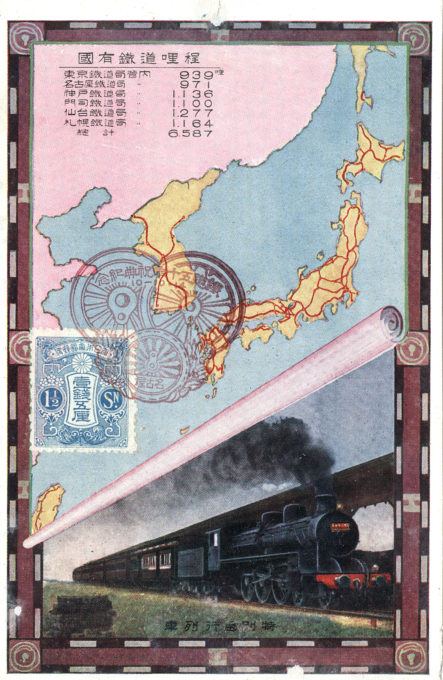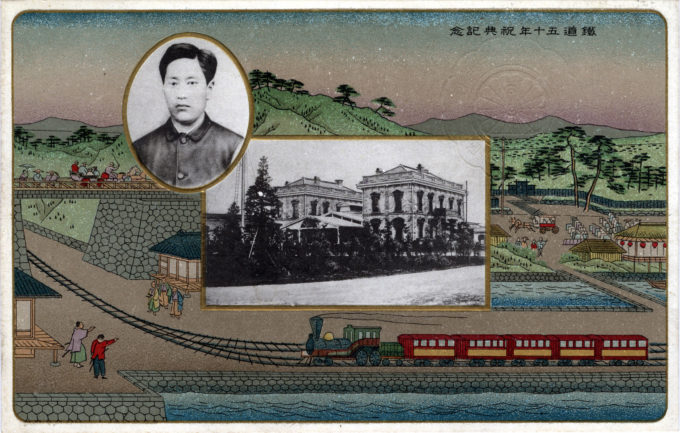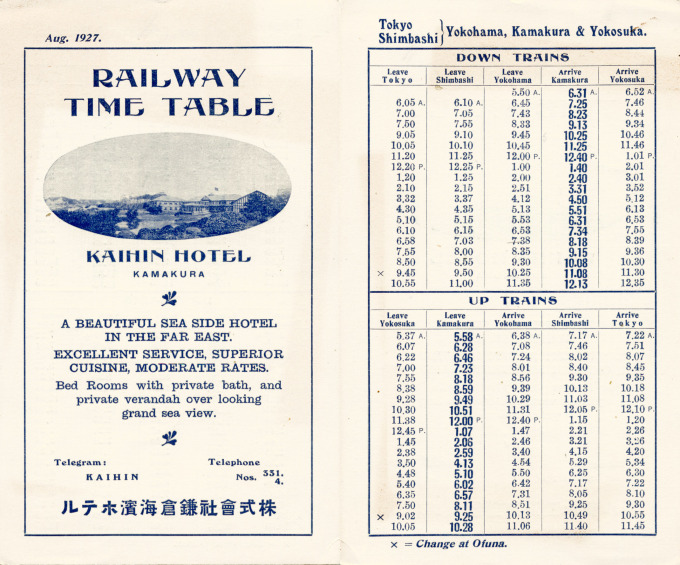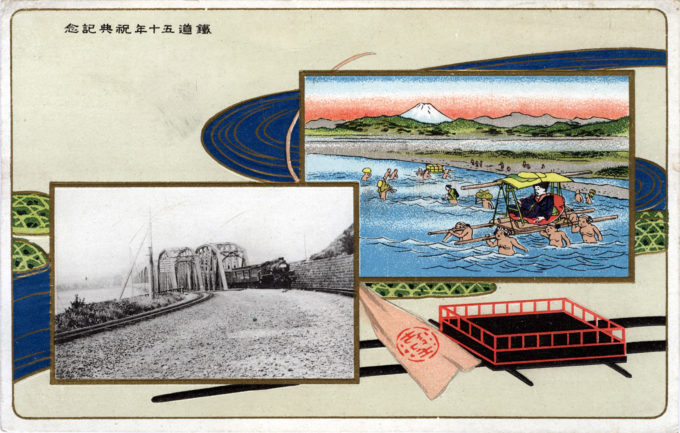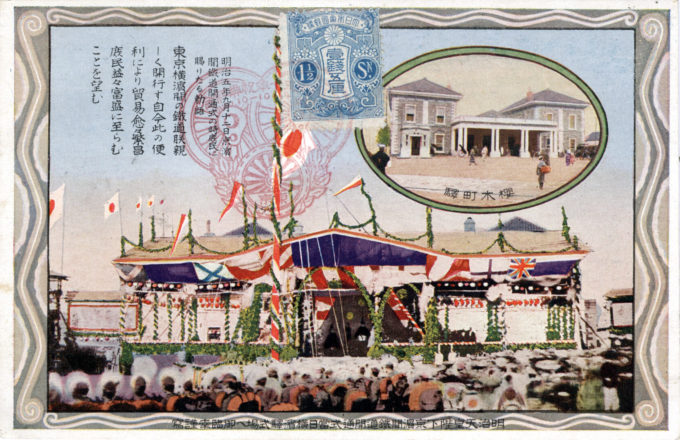
50th Anniversary commemorative postcard of the Japanese Imperial Government Railways, 1922, displaying the celebration held at Sakuragicho Station, Yokohama. Inset image shows the original Yokohama city terminal at Sakuragicho, Japan’s first train station, opened in 1872.
See also:
Sakuragicho (Yokohama) Station, c. 1910
Shimbashi Station (Shiodome), 1872-1909
“On 7 December 1869, Harry Parkes [the Consul General of the United Kingdom to the Empire of Japan from 1865–83] met the heads of the Meiji government to discuss basic measures for introducing railways and telegrams in Japan.
“… It was decided to build the country’s first railway over the 29-km distance between Tokyo, Japan’s capital, and Yokohama, one of the few ports open for international trade at that time. The preliminary survey work began on 25 April 1870. The terminal in Tokyo was to be built at Shimbashi-Shiodome and the terminal in Yokohama at Noge Kaigan [Sakuragicho]. These two places were chosen because [both locations] were close to the city sections and the foreign settlements.
“Service started with nine round trips daily. A one-way trip took 53 minutes.”
– Dawn of Japanese Railways, Japan Railway & Transport Review, No. 1, by Eiichi Aoki, March, 1994

“50th Anniversary of Imperial Government Railways”, Tokyo Central Station, Tokyo, Oct. 14, 1922. Portrayed are (left) Okuma Shigenobu, Vice Minister of Finance in 1872 (and, later, Japan’s 8th and 17th Prime Ministers), and (right) Ito Hirobumi, first Prime Minister of Japan but Minister of Public Works in 1873 at the time the Imperial Government Railways was created. Ōkuma was an early advocate of Western science and culture in Japan, and the founder of Waseda University.
“In the Empire of Japan there is now open to railway traffic 5,000 miles of line. The first rail laid in Japan was in the year 1872, when the Government built the railroad from Tokyo to Yokohama, a distance of 18-miles. The next ten years saw only 114-miles of railroad in Japan and, in 1883, the first private railway company was established. There are altogether 19 separate lines.
“50th Anniversary of Imperial Government Railways” commemorative postcard, 1922, displaying a map and tally of the railroad mileage managed by the Ministry of Railways totaling more than 6500-miles.
“In the year 1906, seventeen private railways were by act of the Diet placed under Government ownership the period within which it was provided they should so be nationalized being ten years, but, as a matter of fact, the purchase was effected within one year.
“There has been a steady improvement in the railroad equipment, only a few years ago, so extremely primitive, and even up to a few months ago, owing to the necessity for economy, showing little change. Now, however, the railway board under Baron Goto, who is the active Minister of Communications, is effecting changes and making additions to the accommodations for travelers.
“Across Japan, the lines pass through most attractive scenery, and historic places can be easily visited but unfortunately these are, as a rule, entirely neglected by the visitor to Japan.”
– ‘The Railroads of Japan’, The Overland Monthly, January 1910
- “50th Anniversary of Imperial Government Railways”, 1922. Photo inset at center is of Japan’s first railroad station at Sakuragicho, Yokohama, opened in 1872. Upper-left is pictureda young Inoue Masaru, who was appointed the Director of Railways at age 29. His many years as head of the bureau earned him the reputation as ‘father of the Japanese railway system’. In 1891, after retiring from government service, Inoue founded Japan’s first locomotive manufacturer.
- “50th Anniversary of Japanese Railways” commemorative postcard, 1922, displaying an inset photo of Tokyo Central Station (completed in 1914) over a motif of the elevated Tokyo railway. Pictured at left is Okuma Shigenobu, Vice Minister of Finance in 1872 and an early advocate of Western science and culture in Japan. At right is Prince Sanjo Sanetomi, Minister of the Right at the time the first meetings were held by the Meiji government regarding railway development in Japan.
“The Railways (tetsudo, or ‘iron road’) are owned and operated chiefly by the Railway Bureau (tetsudokyoku) of the Imperial Japanese Government and are excellent, well-managed, and remarkably safe. In point of general trustworthiness and equipment, they compare favorably with those of the most progressive countries of the world.
“The extensive system is undergoing steady improvement, and the aim of the Gov’t is to gridiron the Empire with railroads which eventually will rank as high as those of America, Germany, and England. The narrow gauge (3 ft. 5 in.) precludes the doubtful luxury of high speeds but so makes for safety that bad accidents are rare. The lines are run on business methods to please and to serve the public, and the system is almost as thorough as that of Germany.
“… Distances are relatively short and, as the scenery along many of the lines is not only charming but in places magnificent, the stranger should plan to do as much traveling as possible by daylight … The best equipment includes toilet arrangements, electric lights, fans and bells, steam heat, thermometers to register the temperature, slippers for the use of passenger,s and many little conveniences as pleasing as they are unexpected … Passenger trains are always in charge of a passenger guard (sha cho), an English-speaking Japanese who wears a red band on his coat sleeve who is always polite and solicitous of the comfort of travelers and who does not expect a tip every time he extends a courtesy to a stranger.”
– Terry’s Japanese Empire, T. Philip Terry, 1914


